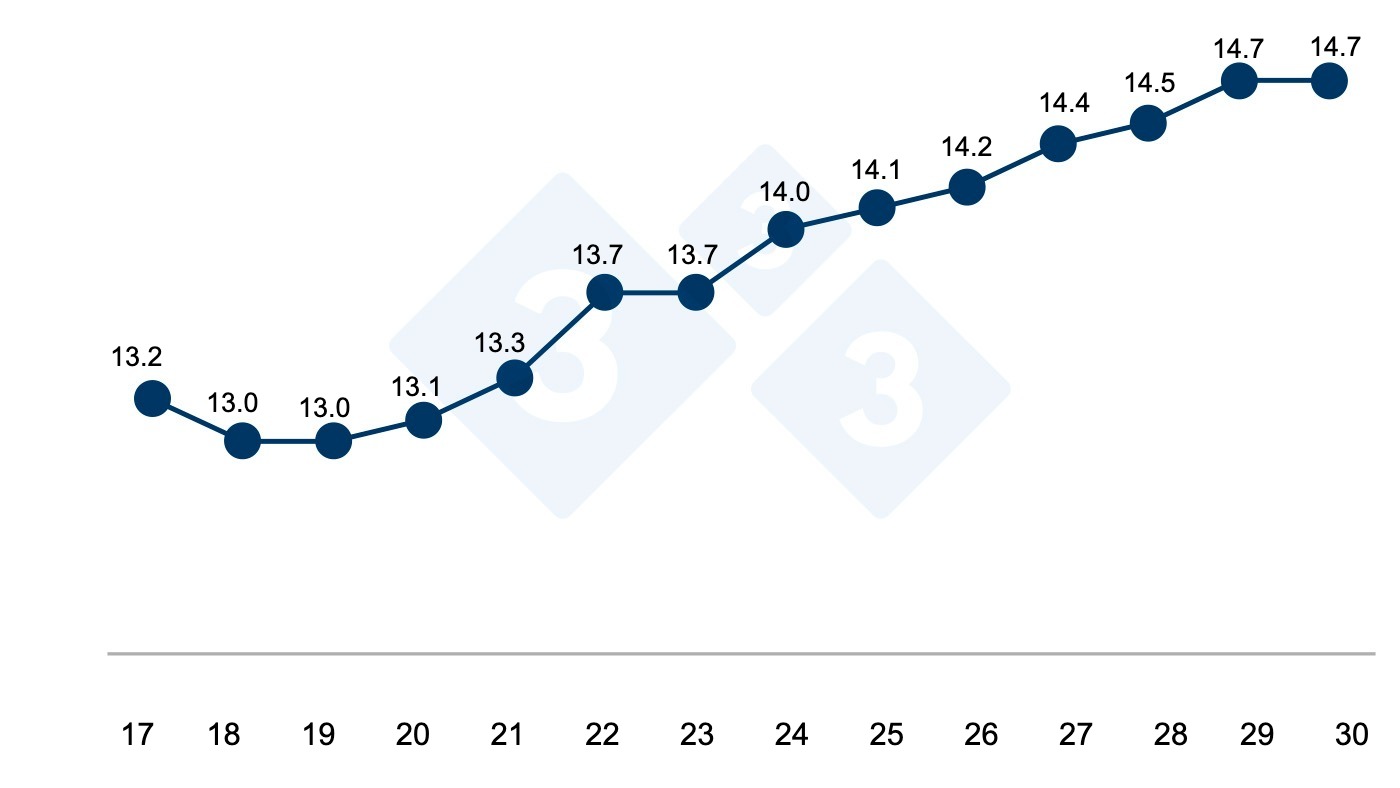The sow
Litters / Sow / Year
Normally the productivity of the sow is valued for the number of litters/sow/year multiplied by the number of weaned piglets per litter. The calculation of litters/sow/year is the following:

Of these three factors, DG is the least variable, normally IWM varies slightly and DL varies according to the time of weaning. In theory, with a theoretical birth rate of 100% and a weaning-mating interval of 5 days, the “maximum” capacity of a sow for producing litters in one year according to the duration of lactation is the following:
In theory, the interval between litters is 141 days for weaning at 21 days and 148 days for weaning at 28 days. The existing difference of 7 days represents 0.12 litters/sow/year which when multiplied by a supposed number of 10.5 weaned piglets per litter would represent 1.26 weaned piglets more with a weaning at an average of 21 days. This ideal scenario is never produced in herds since there are always some reproductive failures which generate NPD (non-productive days) that must be added to the interval between litters. So, for example, a herd with weaning at 21 days that has 14 NPD per litter produces 2.35 litters/sow/year ( 365/ (141 + 14) ) while another with 28 day weaning with 11 NPD produces 2.29 litters/sow/year ( 365/(148+11)). From the data obtained from more than 100,000 first matings we can observe that this theoretical difference of 7 days between the two types of weaning is in fact reduced in practice due to a higher birth rate (principally lower percentage of repetitions) with 28 days of lactation. The figures indicate that the intervals between litters are the following:
- Weaning 21 days: 151 days: 2.41 litters/sow/year.
- Weaning 28 days: 154 days: 2.37 litters/sow/year.
Conclusion, the theoretical difference of 7 days between the two types of weaning is reduced to 3 days and as a consequence the theoretical difference of 0.12 litters/sow/year is reduced to 0.04.
Total born
The duration of lactation affects the number of total born. There are marked differences in this parameter according to genetic type. Genetic types with the potential for high prolificacy respond very generously the more time they have in which to produce the uterine involution. Figures from PigChamp Pro-Europa with a base of 850,000 litters (14 year study) show that there is only a difference of 0.3 in total born per litter in favour of 28 day weaning. These results remain the same if the study only analyzes the last 5 years. However, when we carry out the same study with data of hyperprolific sows we can see that there are some very important differences according to the duration of lactation.
Possibly this enormous genetic improvement in recent years is the best justification for the practice of 28 day weaning with respect to the productivity of the sow.
The data obtained shows that with 28 day lactations there are 14.5 total born while with lactations of 21 days there are 13.3 total born piglets. The difference is very important: 1.2 piglets.
With these data, the total piglets born/sow/year is:
- Weaning 21 days: 2.41 litters/sow/year x 13.3 = 32.05 total born/sow/year.
- Weaning 28 days: 2.37 litters/sow/year x 14.5 = 34.36 total born/sow/year.
If we suppose a total mortality in maternity of 20% ( 9% born dead + mummified plus 11% pre-weaning mortality), the total of weaned piglets per sow and year with the two systems is as follows:
- Weaning 21 days: 13.3 total born – (1.19 + 1.33) = 10.75 weaned piglets/litter x 2.41 = 25.97 weaned piglets/sow/year.
- Weaning 28 days: 14.5 total born – (1.30 + 1.45) = 11.75 weaned piglets/litter x 2.37 = 27.84 weaned piglets/sow/year.
The initial aim of weaning 200 kg/sow/year is more assumable with 28 day weaning since if we multiply 27.84 x 7.5 kg/piglet = 208.80 kg LW weaned per sow and year. The same calculation for 21 day weaning indicate that it is very difficult to reach this objective (25.97 x 6.7 kg/piglet = 173.99). Weaning at 21 days with an average weight of 6.7 kg/piglet, we would need to wean 29.85 piglets/sow/year in order to reach the target of 200 kg per sow. While with 28 day weaning and a weight of 7.5 kg we need to wean 26.66 piglets/sow/year to reach the same objective and this is more assumable when working with sows that are not as prolific as those described in the previous graph.
Author’s note: I would like to express my thanks to PigChamp Pro- Europa and to Servicio Técnico de Cefusa for supplying the field data without which it would be difficult to argue the points made in this article.



